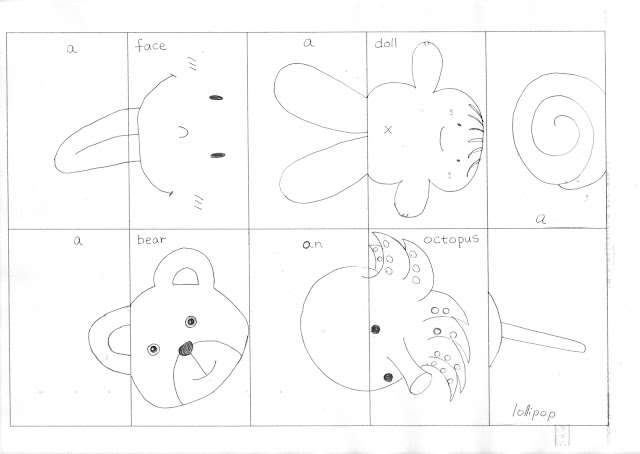- Key words: vocabulary, speaking, verb usage (Do you know…)
- Learner English skill level: Intermediate (third year junior high school)
- Learner age level:
- Preparation time: 20 minutes
- Activity time: 50 minutes for all activities
- Materials: one regular size deck of cards (see below), one oversize deck of the same cards
What the heck is this? That's the question I asked myself after pulling this one out of the mold encrusted box cluttering my closet. Then I remembered I used this activity to review and practice the target phrase, "Do you know what this is?" It also introduces and helps students practice saying the appropriate response, "I think it is a/an _____." The deck consists of 20 pairs of cards that when correctly matched form a picture (a hat, a cup, etc.).
First introduce and practice the phrase: "Do you know what this is?" Then introduce and practice the appropriate response, "I think it is a/an _____." Next, using matching pairs of cards, review the vocabulary you see written on the card set. Use A4 (about letter size) size cards or larger to introduce the vocabulary.
First introduce and practice the phrase: "Do you know what this is?" Then introduce and practice the appropriate response, "I think it is a/an _____." Next, using matching pairs of cards, review the vocabulary you see written on the card set. Use A4 (about letter size) size cards or larger to introduce the vocabulary.
 There are twenty matching cards in the deck that when matched correctly depict twenty different objects. After you've gone over the vocabulary words for each of those objects, hang one card on the board (half a picture) along with a few possible matches and ask the class: "Do you know what this is?" Give the first student to answer correctly one of the two matching cards and repeat the exercise as many times as you think necessary.
There are twenty matching cards in the deck that when matched correctly depict twenty different objects. After you've gone over the vocabulary words for each of those objects, hang one card on the board (half a picture) along with a few possible matches and ask the class: "Do you know what this is?" Give the first student to answer correctly one of the two matching cards and repeat the exercise as many times as you think necessary.When you're finished, ask six students (maybe those who collected the most cards) to come up to the front of the class so they can help you model the next part of the exercise. Give each student one card (void of any text). Then have them hold the card out and in turn ask each person in the group of six, "Do you know what this is?" Once a student has found the person with the matching card, who uses the appropriate response, they can both return to their seats. Next ask another group of six up to the front of the class to model the exercise once again. This time instead of asking the question in turns, the students ask in random order all at once. As before, once they find the person with the matching card they may return to their seats.
Next distribute one card to every student in the class. Ask everyone to stand up and repeat the exercise they have just watched, only this time involving everyone in the class. Once two students have found a match to their card they can return to their seats.
All the students should have been able to ask the target question more than a few times. When everyone is finished and seated, look at each student's card and ask them individually: "Do you know what this is?" This will give all the students a chance to use the appropriate response phrase and you a chance to see what they have learned.
That's basically what this is.






























